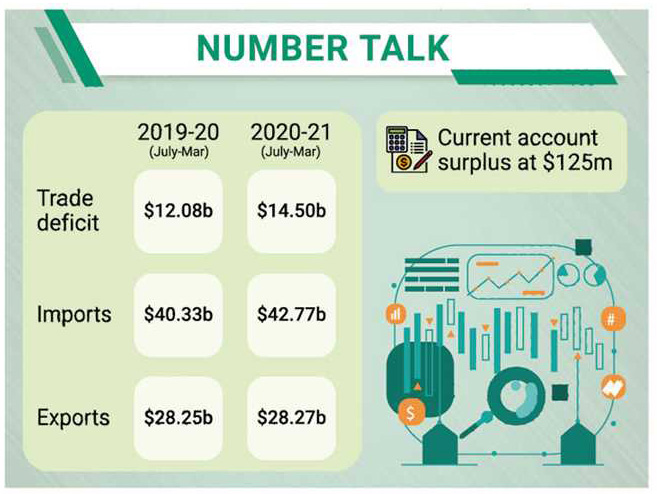
Trade gap widens on imports
Deficit crosses $14b in nine months of FY21
SIDDIQUE ISLAM | Friday, 21 May 2021
Bangladesh's trade deficit widened by more than 20 per cent in the first nine months of the current fiscal year (FY) because of rising import payment pressure on the economy, officials said.
The trade deficit with the rest of the world crossed the US$14 billion level and stood at $14.50 billion during the July-March period of FY 2020-21, from $12.08 billion during the same period of the previous fiscal, according to the central bank's latest statistics.
Import payments have increased significantly in recent months mainly due to higher purchase of raw materials for readymade garments along with resumption of infrastructure development works across the country, the officials explained.
Import payments grew by 6.04 per cent to $42.77 billion during the period under review from $40.33 billion in the same period of FY'20.

Actual imports through back-to-back letters of credit (LCs) of ready-made garment (RMG) products rose to $563.43 million in March 2021 from $502.21 million a month before, the BB data showed.
On the other hand, export earnings increased by 0.06 per cent to $28.27 billion in the first nine months of FY'21 from $28.25 billion a year ago.
Talking to the FE, Khondaker Golam Moazzem, research director of Centre for Policy Dialogue (CPD), said the existing trend of overall trade deficit might continue by the end of this fiscal year.
He also said the country's export earnings might improve in the near future following shifting of orders from China and Myanmar recently.
Imports of raw materials and intermediate goods are likely to increase in the coming months while essential items' imports are expected to remain stable, according to Dr Moazzem.
But a BB senior official predicted that the growth of foreign trade covering both export and import might rise further by the end of this fiscal year.
The upward trend of import payment obligations pushed down the current account surplus significantly despite higher growth of inward remittances, according to the central banker.
The current account surplus stood at only $125 million in the nine months of FY'21, which was a $2.65 billion deficit in the same period of the last fiscal year. Such surplus was $1.37 billion a month ago.
Meanwhile, the flow of inward remittances grew by 35.06 per cent to $18.60 billion during the period under review from $13.77 billion during the same period of FY'20 despite the ongoing Covid-19 pandemic globally.
On the other hand, the financial account's surplus grew by more than 99 per cent to $6.94 billion during the July-March period of FY'21 from $3.48 billion in the same period of FY'20.
Higher inflow of net other investment has helped achieve higher growth of the financial account surplus despite the falling trend in net foreign direct investment (FDI), another BB official said.
As a result, overall balance of payments (BoP) rose to $6.99 billion in the first nine months of FY'21 from $624 million in the same period of the previous fiscal.
[email protected]